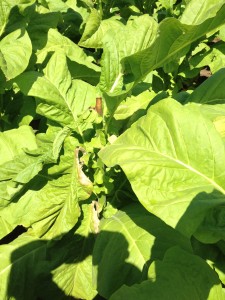September 9, 2014
by CTRF
Comments Off on Last Harvesting Pass Occurring Now on Several Farms
Several growers have now started their last harvesting pass. As for when harvest will be completed, on most farms it will likely take most of September provided the weather cooperates.
Several fields are now showing more maturity as of late. Cured quality continues to be good. There are no widespread problems to report.
White Mould (caused by Sclerotinia sclerotiorum), which was reported in the last post, continues to be seen in certain fields. Damage from this disease can occur on leaves, as well as on the stalk. A thick, white-coloured mould will be present and will often contain black, pea-sized overwintering bodies called sclerotia. Leaf drop can occur when the infection is at the leaf axil.

Injury from White Mould on the stalk that has caused the leaf to fall off the plant.
At this time in the season, there is no control for White Mould. This disease is not known to spread during curing, however, infection from Pole Rot (see below) can occur in the wound created by the White Mould. More information on White Mould can be found in the technical bulletin entitled “Tobacco Pests and Disorders in the Field – White Mould” posted in the plant protection section under the research heading of this website.

Pole Rot on cured leaf.
A disease being seen in some kilns at this time is Pole Rot (caused by Rhizopus arrhizus). This disease appears as a grey, fuzzy mould on the midrib and lamina of leaves. Strategies for limiting damage from this disease are to minimize the time spent yellowing, such as yellowing at as high a temperature as possible (i.e. 40.6°C or 105°F) and then moving quickly to colour fixing which is less favourable for the development of the disease (i.e. above 43.3°C or 110°F). In past years, some growers have been successful with closing the ventilators and flashing the dry-bulb temperature for a short period of time while yellowing. When flashing the temperature, the tobacco first exposed to the incoming air will need to be at the point where it can be dried otherwise green fixation will occur. The flashing procedure is outlined in detail in OMAFRA’s tobacco publication 842.
To date, Blue Mold has not been reported in Ontario this year. As for the U.S., Blue Mold on various types of tobacco has been reported in the states of Virginia, Kentucky, Massachusetts and Connecticut.
Post prepared and sent by Canadian Tobacco Research Foundation
Mailing Address: CTRF, P.O. Box 322, Tillsonburg, ON N4G 4H5
Telephone: 519-842-8997
Web Address: http://ctrf1.com







